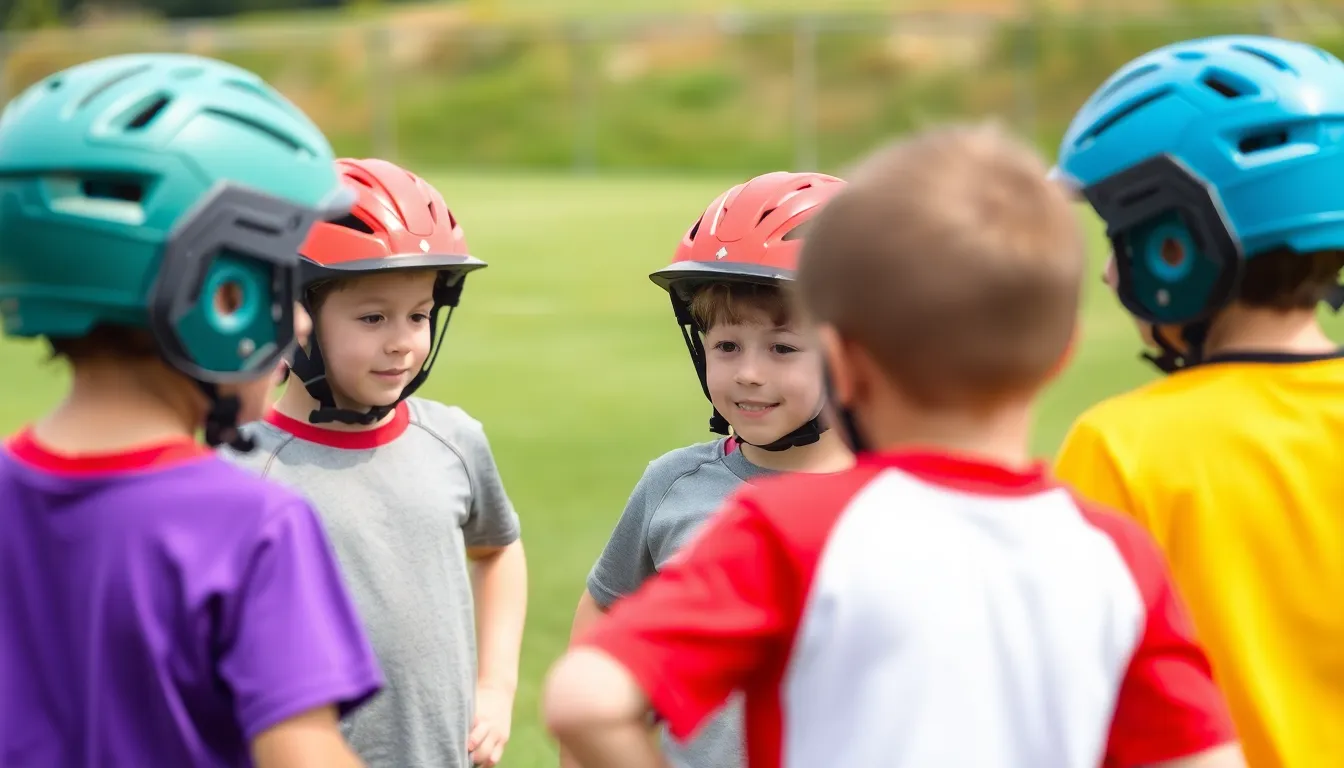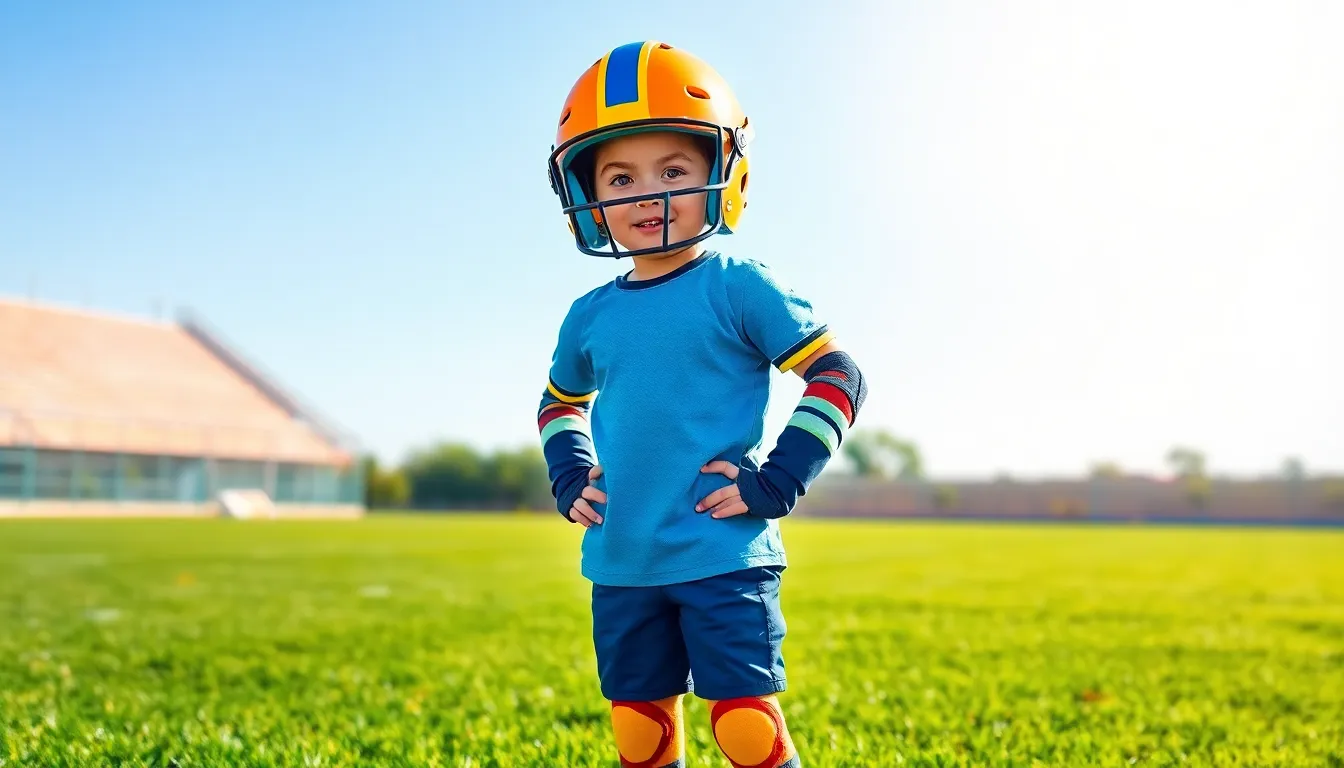Table of Contents
ToggleWhen it comes to kids and sports, safety gear isn’t just a suggestion—it’s a necessity. Picture this: a young athlete zooming down the field, helmet askew, knee pads dangling like a forgotten accessory. Sure, it might look cute, but that’s a recipe for disaster! Investing in the right safety gear can turn a potential trip to the ER into a triumphant victory lap.
Importance Of Kids Sports Safety Gear
Safety gear for kids in sports plays a crucial role in preventing injuries while promoting a positive experience.
Preventing Injuries
Proper safety gear significantly reduces the risk of injuries during athletic activities. Helmets, pads, and appropriate footwear protect against falls and impact. Studies reveal that wearing helmets decreases the chances of head injuries by up to 85%. By using protective equipment, young athletes face lower injury rates, allowing them to focus on skill development instead of recovery. Additionally, safety gear fosters a culture of awareness, encouraging children to prioritize their well-being while participating in sports.
Enhancing Performance
Using the right safety gear improves a child’s overall performance in sports. Confidence boosts when athletes feel secure in their equipment, allowing them to focus on technique and strategy. Research indicates that players wearing appropriate gear experience less discomfort and distraction. This comfort translates into enhanced mobility on the field or court. Improved performance often leads to increased participation, fostering a love for sports and physical activity among young athletes.
Types Of Kids Sports Safety Gear

Numerous types of safety gear exist to protect children during sports activities. Each type plays a vital role in injury prevention and overall well-being.
Helmets
Helmets act as the first line of defense against head injuries in sports like skateboarding, cycling, and football. Wearing a helmet reduces the risk of serious head injuries by up to 85%. Many styles comply with safety standards and come equipped with features that improve comfort and fit. Choosing a helmet that fits correctly ensures maximum protection and encourages consistent use. Regularly inspecting helmets for damage maintains their effectiveness and safety.
Pads and Protective Clothing
Pads and protective clothing offer significant coverage to vulnerable areas such as knees, elbows, and wrists. Various sports, from hockey to soccer, benefit from specialized pads designed to absorb impacts and prevent injuries. Compression clothing also enhances muscle support, improving circulation and reducing fatigue. Ensuring the right fit enhances movement without compromising safety. Upgrading pads and clothing periodically helps maintain optimal protection as children grow.
Footwear
Footwear is crucial for providing stability and support, impacting performance and injury prevention. Specific sports require specialized shoes engineered for traction, flexibility, and cushioning. Soccer cleats, for instance, are designed to enhance grip on the field. Wearing the right footwear can prevent common injuries such as sprains and fractures. Regularly checking for wear and tear ensures that shoes remain effective in protecting young athletes.
Choosing The Right Safety Gear
Selecting appropriate safety gear is vital for protecting young athletes during sports. Prioritizing a gear selection process ensures children stay safe while enjoying various activities.
Sizing and Fit
Getting the right size and fit is essential for effectiveness. Gear that’s too loose can shift during play, exposing areas to potential injury. On the other hand, overly tight equipment can restrict movement and cause discomfort. Proper fitting gear should allow for full range of motion. It’s advisable to measure children’s dimensions accurately and consult size charts provided by manufacturers.
Material Quality
Opting for high-quality materials significantly enhances protection. Durable materials endure impacts and wear, extending the lifespan of safety gear. Look for gear made from impact-resistant composites for maximum safety. Breathable fabrics improve comfort, reducing heat buildup during activity. Safety gear constructed from high-quality materials can support both performance and injury prevention.
Age Appropriateness
Choosing gear suited to a child’s age and sport is crucial. Equipment designed for older children may not offer adequate protection for younger ones. Each sport’s safety requirements can vary, so select gear that meets specific guidelines. Pediatric recommendations often indicate appropriate features for different age groups. Ensure that gear matches the child’s developmental stage to promote safety effectively.
Maintenance Of Sports Safety Gear
Maintaining sports safety gear ensures optimal protection and longevity. Regular checks and proper care can lead to enhanced safety for young athletes.
Regular Inspections
Inspecting safety gear frequently is essential. Parents should look for signs of wear, such as cracks in helmets or fraying in pads. Checking the fit of the equipment ensures it hasn’t become too loose or tight over time. Gear that doesn’t fit properly compromises safety and effectiveness. Make it a routine to assess all equipment before each practice or game to catch any issues. Keeping track of inspection dates helps maintain consistency in this process.
Cleaning and Care
Cleaning safety gear properly promotes hygiene and durability. Many items can collect dirt and sweat, potentially leading to odors and skin irritations. Following manufacturer instructions for cleaning ensures the gear remains intact. For most items, mild soap and water suffice for effective cleaning. Additionally, drying gear thoroughly prevents mold and mildew. Storing equipment in a cool, dry place aids in maintaining its structural integrity. Regular care teaches children the importance of equipment responsibility, ultimately prolonging the life of their safety gear.
Investing in the right safety gear is crucial for young athletes. Properly fitted helmets pads and shoes significantly reduce the risk of injuries allowing children to enjoy their sports safely. This investment not only protects them physically but also boosts their confidence and encourages a lifelong love for physical activity.
Regular maintenance and timely upgrades ensure that safety gear remains effective as children grow. By prioritizing safety gear parents can foster a positive sports experience that emphasizes skill development and enjoyment. Ultimately equipping children with the right gear sets the foundation for a safe and fulfilling athletic journey.





